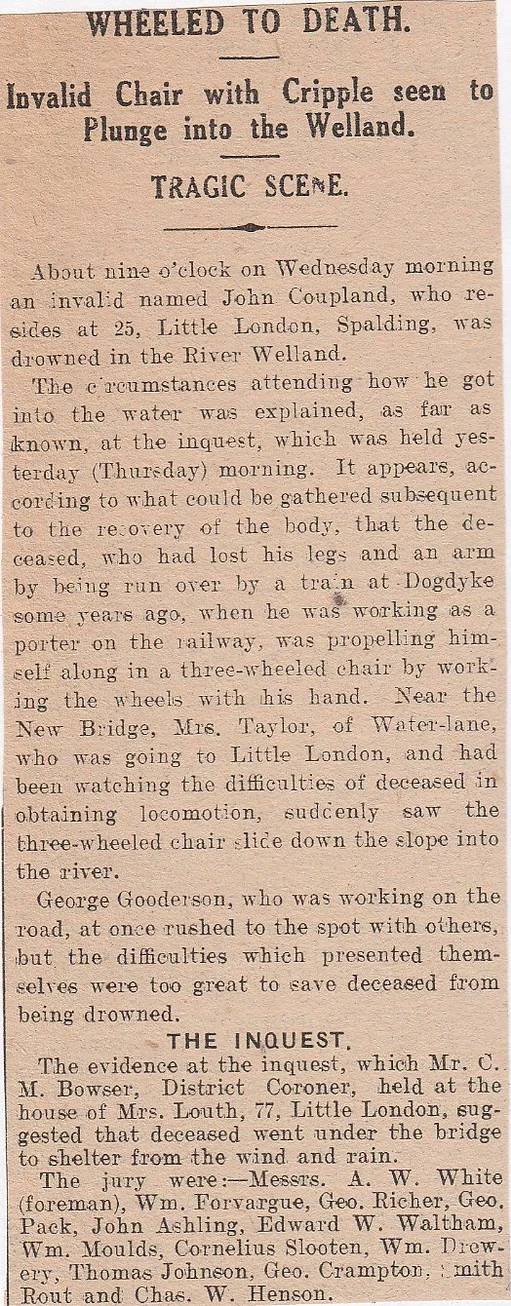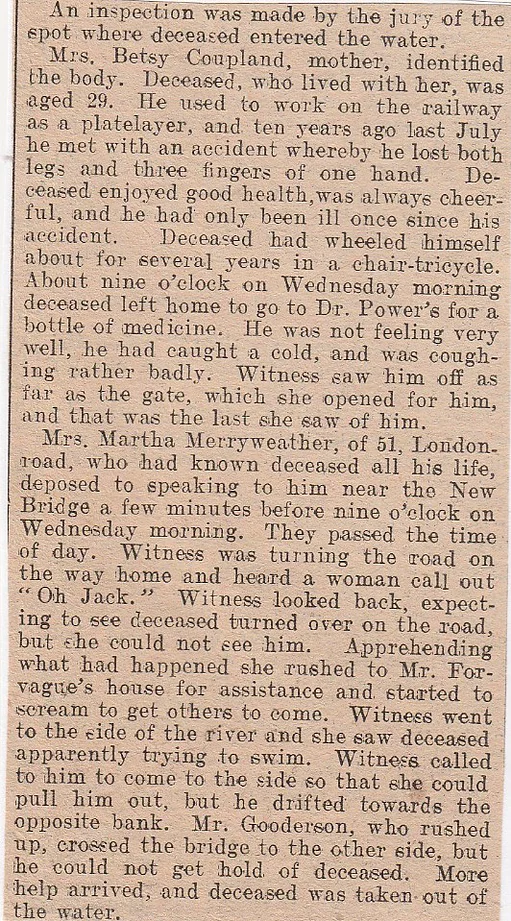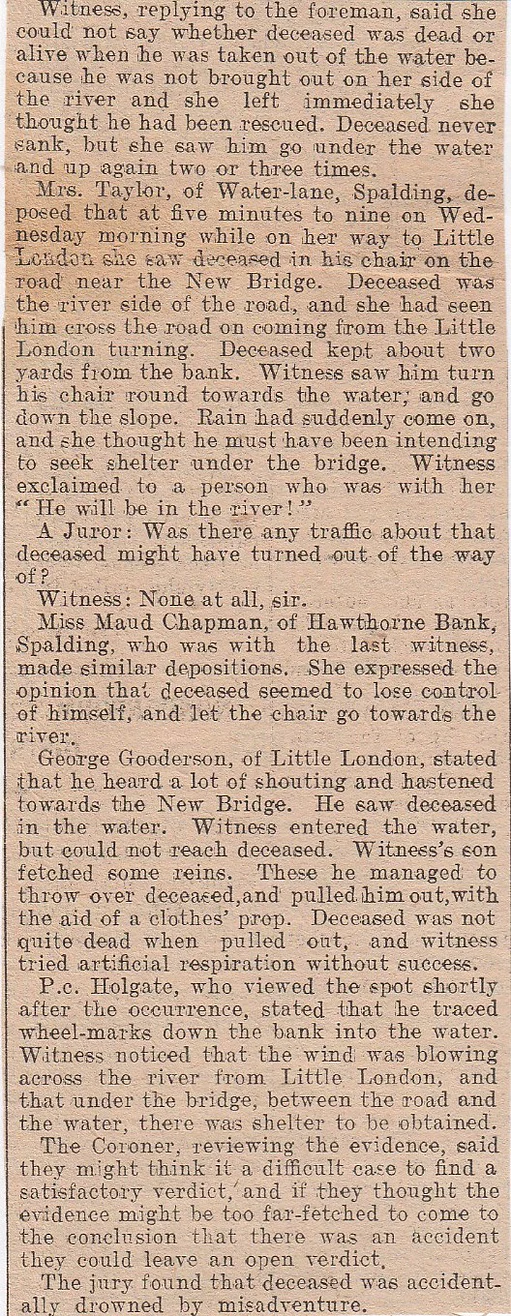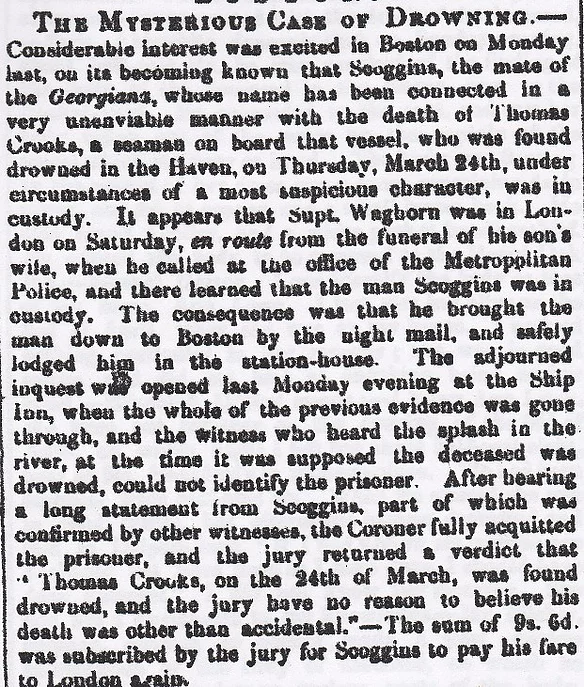Holland and Boston consist of the towns of : Boston, Holbeach, Crowland, Donington, Long Sutton and Spalding.
1/ Spalding Church Suicide, April 1850
Mr Bailey, the parish clerk of Spalding, was found hanging by a handkerchief from a peg in the wall. The verdict was one of “Temporary Insanity” and there is now gossip circulating the town that the church would be re-consecrated before Divine service could be performed again. (What church was the suicide in?)
2/ Boston Cottage Hospital Suicide, September 1883
On a Saturday morning at the Boston Cottage Hospital, a 48-year-old Dock labourer John Nicholls was found hanging from a strap, suspended from an iron railing directly in front of the premises. He had been drinking heavily and his wife found the body.
3/ River Witham Drowning, near Boston, September 1909
Richard Coupland was drowned in the River Witham near Boston, when he went out with two other blokes from Sheffield and another from Boston and went for a sail up the river. They weren’t far out of Boston when the boat capsized, after a gust of wind tipped it over and they were all thrown into the water. The other three were rescued but Coupland drowned.
4/ Spalding Burning Fatality, November 1885
At Spalding, a man named William Kirchin was remanded with the murder of his stepdaughter, Harriet Hoe aged nineteen, by throwing a paraffin lamp at her. The girl’s clothing was set on fire. She was so terribly injured that she died two days later.
5/ Corporation Baths, Boston, (Man Drowned) July 1889
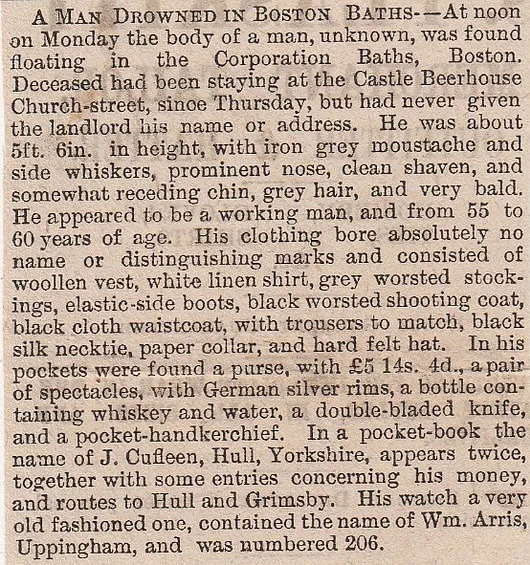
6/ Near Boston (Parish with No Name) November 1885
A farmer’s son named Cox was up in front of the Petty Sessions at Boston charged with assaulting his father. He was fined £5 and bound over to keep the peace for three months. Not very interesting so far! During the case, it was known that the son and father lived together, in a parish which had no name. It is two miles from Sutterton, two miles from Wigtoft, two and a half miles from Swineshead and two and a half miles from Quadring, but owned by none of the above-mentioned parishes. To be fair, there wasn’t a great deal there that anybody would be clamouring for. A pot-holed road of half a mile, with the father and son who despised each other, as the only residents. They also pay no local rates. (Where the hell is this place, in the middle of nowhere?)
7/ Spalding Love Story, January 1897
Around fifty years ago, a Spalding man left his wife and son and went to America. That’s one nasty bugger if ever there was one. It gets worse. The mother and son had to go to the Workhouse and were there for a few years. The mother met someone, then got married again, but he soon died and she was back in the Workhouse again. Let us travel to the U.S.A. and find out what the husband is doing! He was married three times and three times he buried each of his wives. He then walked up the aisle for a fifth go at marriage, this time in Manchester in England. This missus found out about the living wife in Spalding and then walked out on him. The man thought about his wife in Spalding and went back and saw her, then rekindled his love for her and he asked her to come and live with him and to leave the dreary Workhouse. Most women would have told him to shove it, but they now live together. The husband is eighty and the wife, a sprightly seventy-five.
8/ Boston Ice Company, Boston, (Mangled to Death) September 1896
A 24-year-old engineer named Palmer had a nasty accident while working some machinery, at the Boston Ice Company’s factory. His clothes became entangled and he was dragged into the cogs and workings. When eventually pulled out he was badly mangled. The poor chap died within minutes.
9/ Fulney House Butler Suicide, near Spalding, August 1886

10/ Holbeach, Lightning Death, July 1897
A young boy by the name of Herbert Marshall was struck by lightning and instantly killed when a passing thunderstorm was over Holbeach one evening.
11/ Holbeach Lightning Death, August 1894
Another lightning strike in Holbeach, but this was three years earlier. Two men, John Barsby and Richard Barney, were out harvesting in a hay-field at Holbeach when lightning struck the pair of them and again resulted in death on the spot.
12/ Holbeach Clough Manslaughter, February 1870
A horrific accident happened at Holbeach Clough, when a labourer named Peasgood had been out in the morning looking for work, but came home with nothing to show for his efforts. In the corner of the room was a loaded rifle, which he grabbed hold of then blew his wife away, purely by accident. It was proved to be just a careless act of a weary man. He was arrested and will be indicted for manslaughter.
13/ Holbeach Murder, November 1863
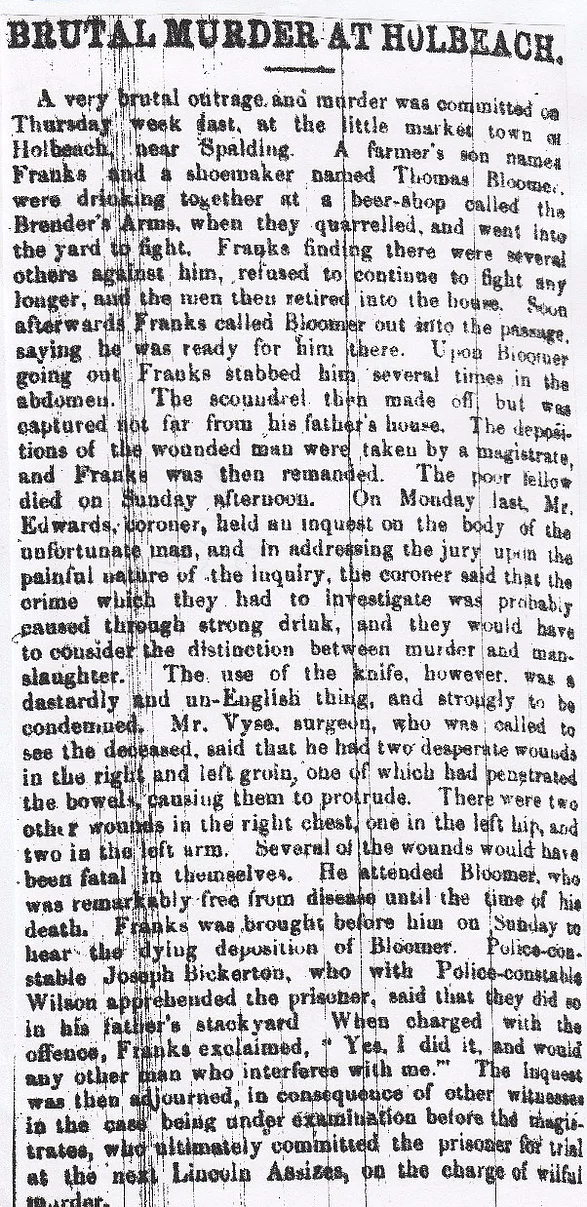
Holbeach Murder, (Sentence) March 1864
John Franks aged twenty-nine, a labourer, was indicted for the wilful murder of Thomas Bloom at Holbeach on October 29th, 1863; and was further charged with killing and slaying the said Thomas Bloom. The bill for murder was ignored by the grand jury and the prisoner pleaded guilty to the minor charge of manslaughter. The death of the deceased arose out of a quarrel at a pub and in the scuffle, the murdered man received seven stab wounds, one of which let out a portion of his intestines. Sentenced to twenty years penal servitude.
14/ Holbeach Preacher Death, August 1889

15/ Spalding Station, May 1901 (Two Strange Characters)
One of the two people who is regularly spotted at Spalding Station, is an old lady who wanders up and down the platform waiting for her son to arrive at Spalding. Her son died at sea several years since, but obviously, something in her brain clicked and she goes there, come rain or shine, to greet him home, maybe three or four times a day. The other person is a giant fellow, slightly retarded, who firmly believes that he is a policeman who is on special duty.
16/ Great Northern Goods Station, Boston, April 1900 (Human Remains)
The arm bone and hand of a human were seen sticking out a sack at the Great Northern Goods Station in Boston. Police were immediately called upon and when they searched the sack it was found to contain several skulls and dozens of human bones. They were in fact taken to a marine store dealer, after the sale of a local doctor’s effects and they were being transported with animal bones to a medicine works at Newark, to be converted into bone manure. The authorities demanded that the human remains be given a decent burial.
17/ River Welland, Spalding, (Man’s Head Discovered) February 1882
A couple of workmen were dredging the River Welland near Little London, when they brought up the head of a man. The post-mortem showed that it was the head of an elderly man, with the brain in an amazing condition considering where it had been. He also stated that it had been in the water for a very long time. Police are looking into the mysterious affair.
(Does anyone know who the head belonged to?/ Was he a murder victim?)
18/ Stanbow Lane Suicide? Boston, February 1955
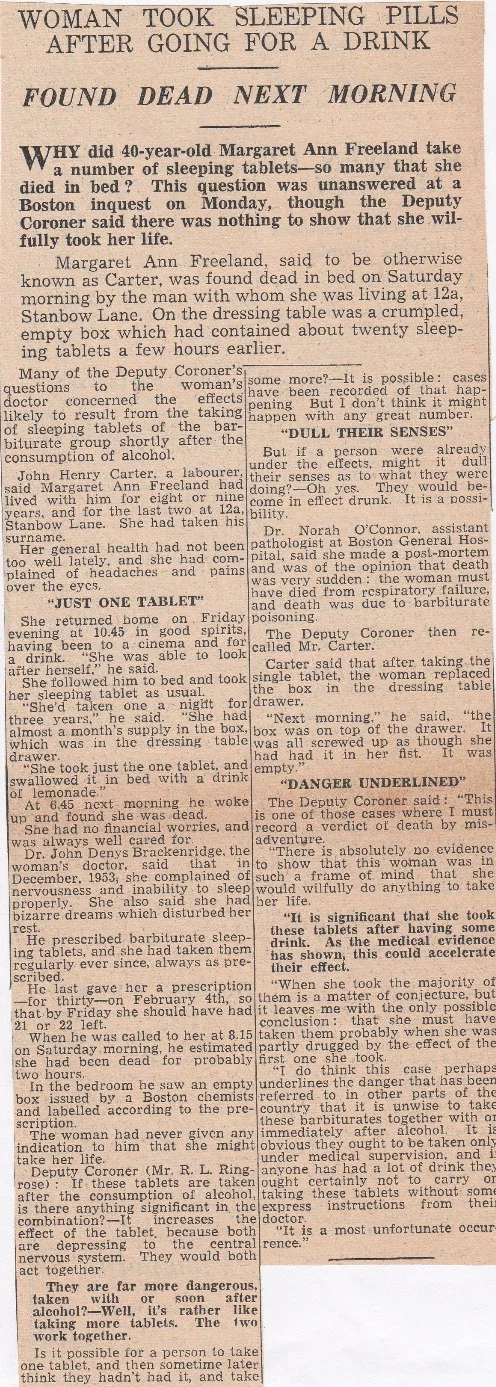
19/ Wrangle Fatal Fire, January 1894
Three people died in a fire at Wrangle. An old couple by the name of Collins and their imbecile son, all burned to death. Their cottage was a mass of flames, with nobody seeing the inferno in the snowstorm, is slightly surprising, until it was all too late.
20/ Fleet (near Holbeach) August 1910 (Suicide Replica)
Sixty-one-year-old, Mrs Josephine Ann Hilliam, a well-respected family in the county of Lincolnshire, killed herself in a summer-house by hanging. Probably not a coincidence, but a deliberate act on her part to mirror exactly what her husband did six months ago. His suicide had haunted her these past few months and she threatened suicide on several occasions. The daughter found the body.
21/ Frampton West, August 1901 (Killed by Traction Engine)
Frampton West near Boston was a scene of horror when Joseph Dawson’s traction engine was making it’s way to a farm to aid in the threshing process. 60-year-old Daniel Hubbard from Boston, who was the guy in front with a flag warning people of its presence, when he tripped and fell in front of the behemoth. It squashed him like a fly and death was instantaneous.
22/ Algakirk Station Death, August 1884
The gatekeeper of Algakirk Station, a chap named Childs, was killed by an excursion train at the said station on Saturday.
23/ Algakirk Manslaughter December 1866

24/ Crowland Child Murder, May 1871
A well-respected member of the parish of Crowland, a married woman named Beale, who was a mother of nine, killed little two-year-old Fanny Beale by decapitating it with a razor while she slept in her cot. Apparently, she has been showing signs of a mental breakdown recently. Her husband had gone to Peterborough market and she wafted the other kids out of the house and told them to go and play in the field at the rear of their house. The eldest of her children, a thirteen-year-old girl thought something was amiss and stayed in the kitchen, but didn’t hear a scream or crying. Mrs Beale has been arrested.
25/ Sutterton Suicide, June 1916
A twenty-five-year-old farmer named Charles was discovered in a ditch on his farm at Sutterton, with his throat slashed from ear to ear. It was his two sisters that found the corpse, while they were out for a stroll. Charles was fearful of getting called up for service and didn’t want to go to fight the Germans. He thought the best way out was suicide.
26/ Sutterton, May 1913 (Fatal Car Accident)
A young lady named Alice Barnes was killed in a collision with a car at Sutterton while she was riding her bicycle. Her boyfriend was driving the car and she was holding on to it while it was moving, when he swerved at a corner and she fell into the vehicle’s path. Miss Barnes lingered a while, but she expired soon afterwards.
27/ Pinchbeck Child Murder, July 1875
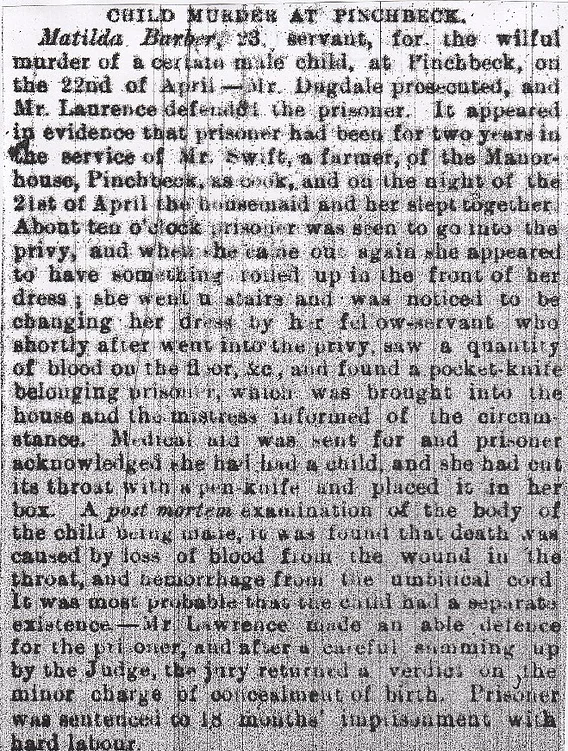
28/ Fishtoft, November 1860 (Vicar’s Fatal Accident)
Reverend.H.Holdsworth, the rector of Fishtoft and chairman of the Boston Sessions, was thrown out of his cart when proceeding to Boston on the 7th November. His arm was broken and it was found necessary to amputate it above the part broken. Morphine was administered after the operation at about eleven o’clock the same night, but the Reverend expired before three a.m. the following morning.
29/ Dawsmere, (Near Holbeach) (Child Shot) May 1889
A group of lads were playing in the house of Mr Ball,when an argument erupted. Mr Ball’s son, who is about ten-years-old, grabbed a gun out of the kitchen and tried to shoot it at one of the boys. There was no cap on it, so it did not fire and the lad ran off. He managed to find such a cap, then pointed it at eight-year-old Ray Scuffham and blew his shoulder away. He fell unconscious to the floor and hopes of him pulling through are virtually zero. (Did he die?)
30/ Carrington Churchyard (Near Boston) May 1828 (Family Deaths)
The following burials have taken place at tiny Carrington churchyard near Boston; Ann Pinchbeck aged twenty, who had just got married in the chapel the week before her funeral; Thomas Webb aged thirty-one, her brother; and finally, his wife, twenty-five-year-old Susan Webb.
The husband and wife had died within eight days of each other.
31/ Stickney, (Frightful Death) June 1862
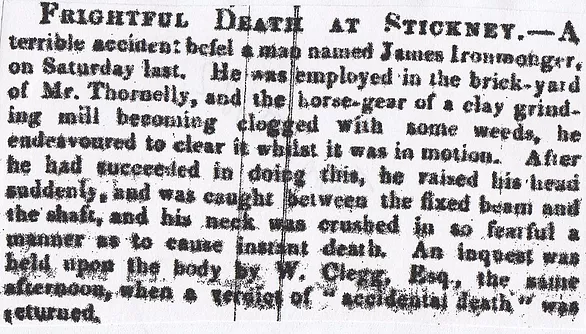
32/ Gosberton Suicide, February 1877
Samuel Everard, a well respected agriculturist from Gosberton, killed himself by shooting himself in the head with a pistol. Mr Everard was a wealthy bachelor and considerable landowner in most of the surrounding parishes. The seventy-five-year-old literally blew his head in half.
33/ “Waggon and Horses” Murder? Kirton Holme (Boston) September 1877
Mrs Bee, the landlady of the “Waggon and Horses” pub in Kirton Holme near Boston, was seen by an opportunist criminal, observing that she was on her own, seized hold of the poker and smashed her over the head and then took off with £15. The perpetrator has not been apprehended and Mrs Bee was discovered unconscious. Such was the ferocity of the attack, that her life is despaired of.
34/ Quadring Poisoning, October 1916
A fatal accident occurred at Quadring, which lies between Spalding and Boston. Youngster John Ackland had been playing with an empty medicine bottle when he very suddenly became extremely ill. He only lasted a few minutes, then breathed his last. The bottle he was messing about with had contained belladonna.
35/ Quadring Bank Suicide, December 1894
The corpse of teenager Henry Garner was discovered at Quadring Bank, south-west of Quadring. The fourteen-year-old lad had for reasons unknown, hanged himself in some stables.
36/ Benington Suicide (Boston) March 1863
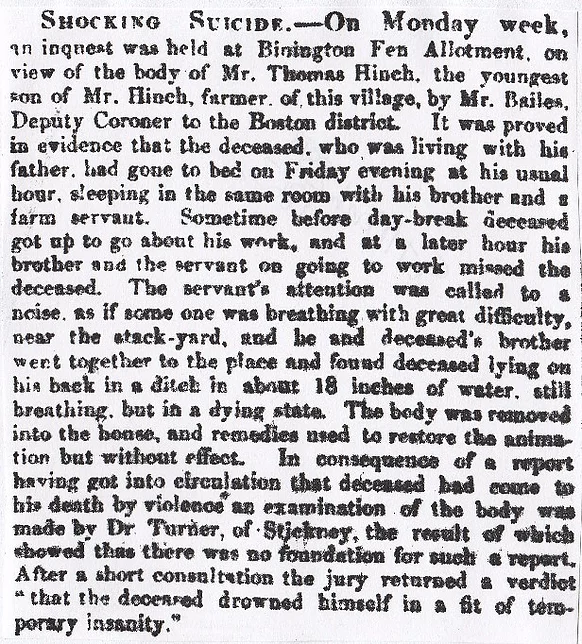
37/ Surfleet Iron Bridge Fatality, September 1884
At Spalding, a man named John Andrews, who was over seventy years of age, died from injuries sustained on the previous day. He was a resident at Spalding and had been assisting at some works in connection with the erection of a new iron bridge at Surfleet. While engaged in winding up a crane which was raising a heavy girder, some of them let go of the handle and deceased being unable to control it, the handle flew round with terrific force, striking him on the head. Andrews’ skull was fractured very badly and he died on Wednesday at Spalding Hospital.
38/ Skirbeck Double Murder, (Boston) June 1900
A bloke with the superb name of Sheriff Taylor aged thirty-two, who was a farmer residing at Washdyke House in Skirbeck, entered his home and started an argument with his missus. He completely lost it and seized a shotgun, then proceeded to blow away his wife and their three-year-old daughter. The features of the victims were barely recognisable by the horrific wounds they suffered. Taylor was a parish constable and had served on Skirbeck Council and was a well-liked member of the community.
39/ Near Gosberton Ice Fatalities, January 1887
A crowd of young people went skating one Tuesday on the Quadring Old Brick-pits near to Gosberton. Two boys, who remained on the ice longer than others, fell into the water and were drowned. They had approached a spot where the ice was not hardened and were immersed. The water was about twenty feet deep and such was the danger attending any attempt at rescue, that no assistance could be rendered. Both the boys, named Quince and Ludlow, aged thirteen and fourteen respectively, were taken out lifeless. The accident occurred at two p.m. and around this time several other lads were immersed in the waters, but no other fatalities were reported.
40/ Whaplode Fen Death, January 1916
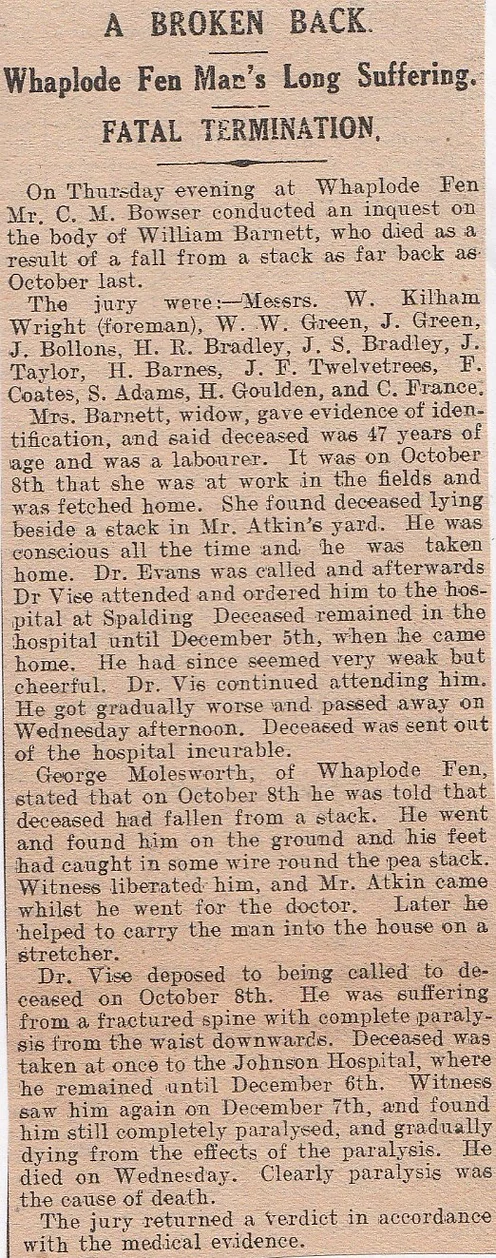
41/ Sutton St James Drownings, February 1891
Two children of a labourer named Bradley were discovered one Sunday, lying dead in a drain at Sutton St James, having evidently fallen in while sliding on the ice.
42/ Near Boston Fatal Shooting, August 1917
An old gentleman by the name of John Wilson was shot accidentally and a young boy was wounded, on a farm near Boston. A lad was working at the farm, was sent by Wilson to get his gun. On his way back the lad met some of the other farm workers, and unaware that it was loaded he slung it over his shoulder, at the same time pulling the trigger and hitting Wilson in the face, killing him on the spot. A boy was also wounded and he was rushed off to hospital.
43/ Holbeach/Pinchbeck Drownings, October 1886
On Saturday a child named Ethel Mary Carr was found by her father in a drain near Holbeach, drowned. The circumstances will be investigated before the Spalding Coroner on Monday.
The previous day, an inquest was held touching the death of an old lady named Lydia Boothby, aged eighty-two, whose body had been found in the Hammond Beck Drain, Pinchbeck West. The deceased had been attending a harvest thanksgiving service at Pinchbeck West, and, returning late at night, had missed her way. It being very dark, she had walked into the drain. A verdict of “Accidentally Drowned” was returned.
44/ Tattershall Road, Boston, (Fatal Accident) June 1895
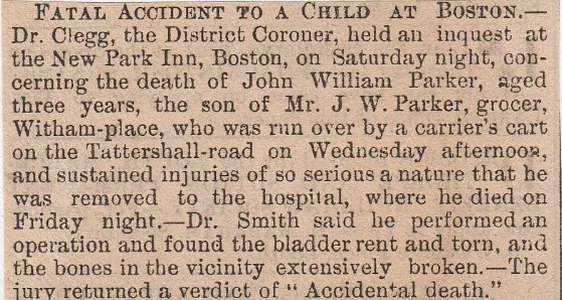
45/ Crowland, (Tragic Death) July 1890

46/ Anton’s Gowt Wife Murder, March 1901 (Gowt means sluice)
William Kirk had been unemployed for some time, so he went to a house of a farmer named Robinson, where his wife was nursing Mrs Robinson there, then violently slashed her throat, nearly severing her head from the body. Just as he was finishing his grisly work, Mr Robinson came in and Kirk threatened him with the same treatment. Kirk was arrested shortly afterwards and his excuse, as was common in most cases, was him being jealous of his wife being there all the time and had often gone round there to ask her to return home.
47/ Boston Child Murder, October 1916
Forty-eight-year-old Henrietta Ellen Smith, a self-confessed opium eater, was found guilty at the Lincolnshire Assizes of the murder of a 1twelve-year-old boy. She had been residing in Boston, away from her husband, and the boy had been adopted by her before the two had separated. Smith was very attached to him but she believed that efforts were being made to bring false charges against the child. Smith confessed to police that she had smashed the boy’s skull in with a poker, then tried to commit suicide by slitting her own throat, thinking they’d be best “out of the way”.(Was Smith insane?)
48/ Spalding Suicide, June 1870
Late one Sunday night, a young lad named Bird, who worked for a confectioner in Spalding, crept out his master’s house and went to an outbuilding at the rear of the premises. He was gone a while and his mistress went to look for him. To her horror, she saw him hanging from a wooden beam, quite dead. Again, suicide often stems from either love or money. This one was down to the fact that his girlfriend had dumped him and didn’t want to see him anymore. In a rash act, the 17-year-old hanged himself out of despair.
49/ Wrangle Poisoning, August 1860
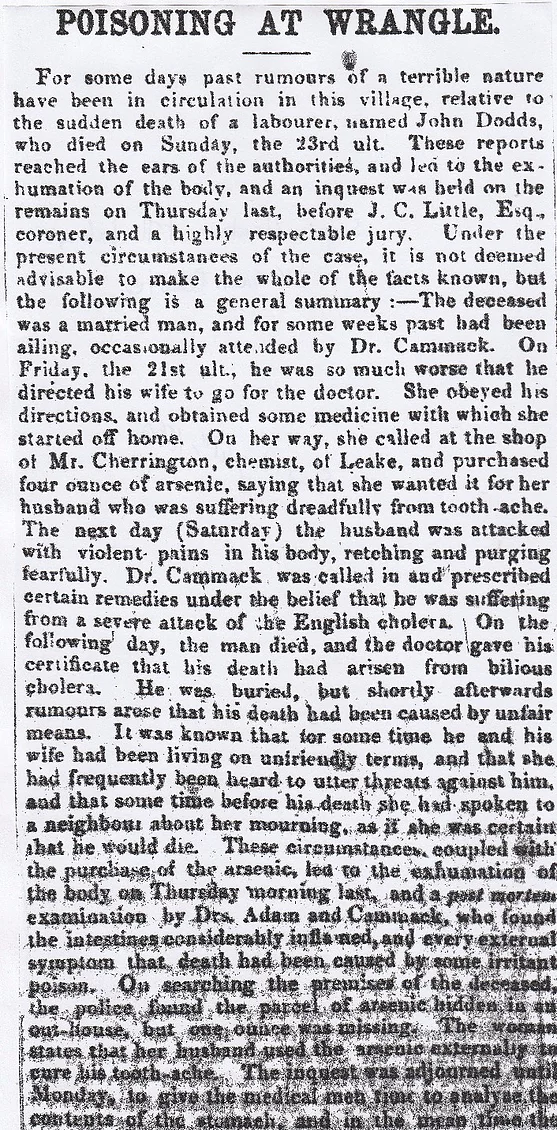
woman remains in the custody of Superintendent Manton, at the lock-up in Skirbeck Quarter.
50/ Stickney Manslaughter, September 1896
Walter William Holmes aged eleven, was charged at Spilsby with the wilful murder of 12-year-old Patience Lily Butler on September 6th at Stickney. Patience worked for Holmes’s father as a nursemaid and when she was seen taking some apples from their orchard without permission, the lad seized his Dad’s gun and shot her, with no apparent warning. He was committed for trial under the lesser charge of manslaughter.
51/ Long Sutton Railway Station Fatality, August 1884
On Sunday night, when the Sutton Bridge train was due in at Spalding at 7-10 p.m. and had just passed Long Sutton Station, a man named William Staniard attempted to cross the line. Before he could do so, however, the engine knocked him down and he was run over. A medical officer of the company happened to be on the train, which was instantly stopped and the man was picked up. The body was much mutilated. The doctor said life was quite extinct and death had been instantaneous. Deceased was middle-aged and was working in a field adjoining the line. He was only a few yards in front of the train when he attempted to cross.
52/ River Nene/Sutton Bridge, August 1893 (Nine Drowned)
The boat which capsized on the River Nene causing the deaths of nine people was recovered. All the bodies were recovered as well and here is a list of the people who drowned.:-
Joseph Birkenshaw aged thirty from Sheffield; Mrs Birkenshaw, his wife; their children, William and Joseph aged six and three; Albert Thompson aged twenty-three; Nellie Hazel aged twenty-one; Joseph Smith aged twenty-six (All of Sheffield). Edward Burton the boatman and his son, Bernard.
Mrs Smith from Sheffield was the only survivor, was heard to say after the accident, “If only they’d done what the boatman told them, none of this would have happened”.
53/ Swineshead Child Shot, August 1887
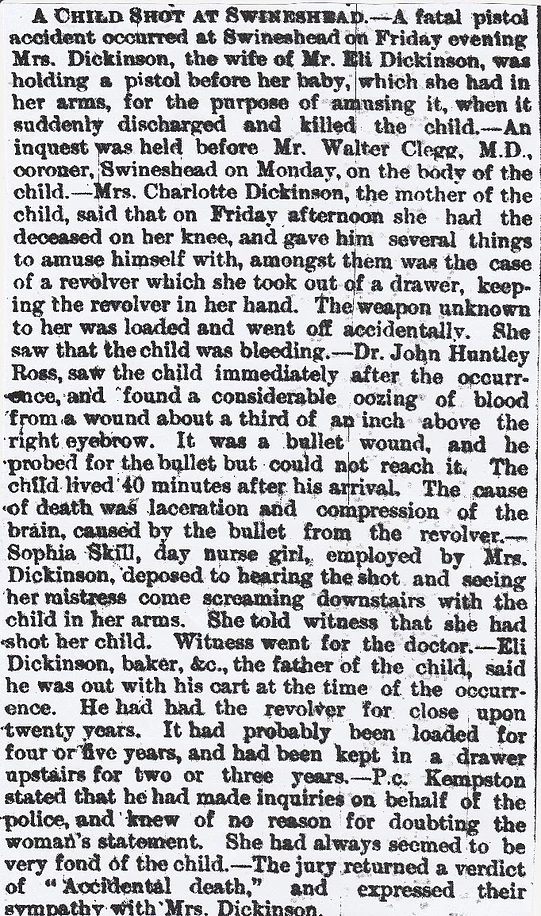
54/ Whaplode Suicide, January 1888
An inquest was held at Whaplode, touching the death of Joseph Greathead, a labourer aged seventy. On the previous morning, a grandchild of the deceased found his dead body hanging by the neck from a beam in an outhouse. Deceased had been very low in spirits since his wife died six months ago. The jury was of the opinion that he committed suicide while temporarily insane.
55/ Frampton Suicide, near Boston June 1895
A cottager named Richard Hoff aged sixty-four, living at Frampton committed suicide by hanging on Monday. He got up shortly after five a.m. and was found soon afterwards by his son-in-law, James Bates, hanging from a beam in the stable. Bates cut deceased down. He was not dead but he died immediately afterwards. Deceased had been low-spirited and strange in his manner since he suffered from influenza some time ago.
56/ Spalding Railway Station (Bridge Death) June 1888
A shocking railway accident happened at Spalding, as the Great Eastern Express from Harwich to Doncaster was passing through Spalding Station yard at 10-50. The driver named Allen, of Cambridge was killed almost on the spot, by his head coming in contact with the top of the footbridge across the line. He was attending the water supply on the tender and standing up, he was struck on the head by the footbridge. His cap was cut through and he died from injuries received in a few minutes.
57/ Stickney Bridge Death, June 1895
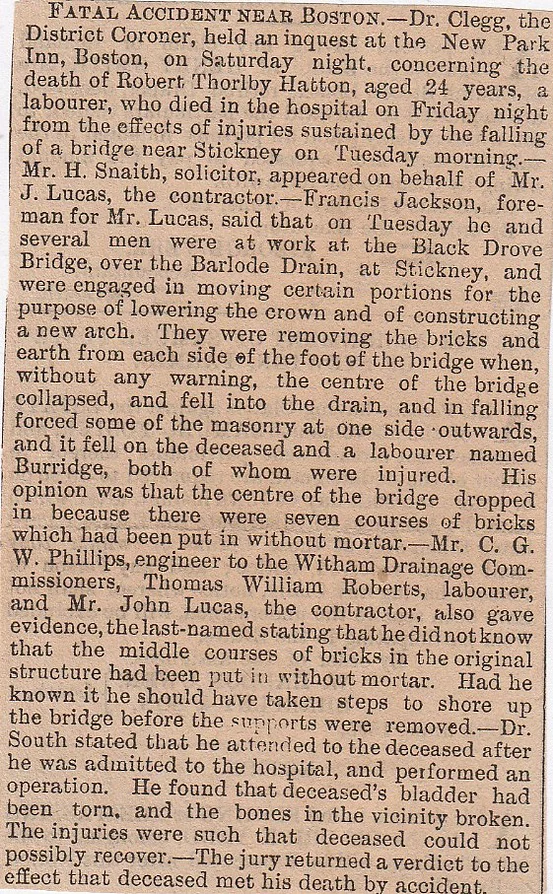
58/ Gedney Hill near Spalding, (Child Poisoned) December 1882
An inquest at Gedney Hill, regarding the body of a child aged nearly three years, son of Mr William Whitsed, of that place, which had died as a result of drinking carbolic acid poison. Mrs Whitsed, the mother of the child, stated that one of the servants was suffering from diphtheria and by the order of the doctor, carbolic acid was used to disinfect the house. On the previous day, she carried the deceased upstairs at the same time carrying a bottle of the acid in the other hand. She then left the child in the bedroom and put the bottle on the mantelpiece. After being away for a few minutes, she heard a terrible scream and ran back to find the child had got up on a chair and had taken a large quantity of the liquid. The child died in terrible agony soon after.
59/ Gosberton Teenage Suicide, August 1889
An inquest into the death of fifteen-year-old David Baxter who hanged himself in an outhouse adjoining his room was held at Gosberton. He lived at home with his parents, then had a few words of disagreement with his father and then went out and hanged himself with a strap he used as a belt, to hook in an outhouse window about three yards from his own door.
60/ Whaplode, (Suicide Makes Sure) December 1882
An inquest was held on the body of William Codlin at Whaplode, who committed suicide in a shocking manner on the previous day. From the evidence, it appeared that the deceased had recently recovered from an illness but for the past few days had been rather despondent. He went to bed on Thursday night and then at around three a.m., the household was awakened by the sound of a gunshot coming from his room. He was found dead in bed. He had first drunk a large quantity of laudanum, then cut a fearful gash in his throat and finally shot himself in the chest. The unfortunate young man was twenty-two-years of age and along with his brother, jointly owned a large farm, with the pair of them being successful breeders of prize stock.
I found in Kelly’s Directory, under Whaplode, a John Codling, farmer grazier and landowner, Cranesgate House (On Cranesgate N., top end, near Sholts Gate)
61/ Donington Fen, (Crushed to Death) December 1915
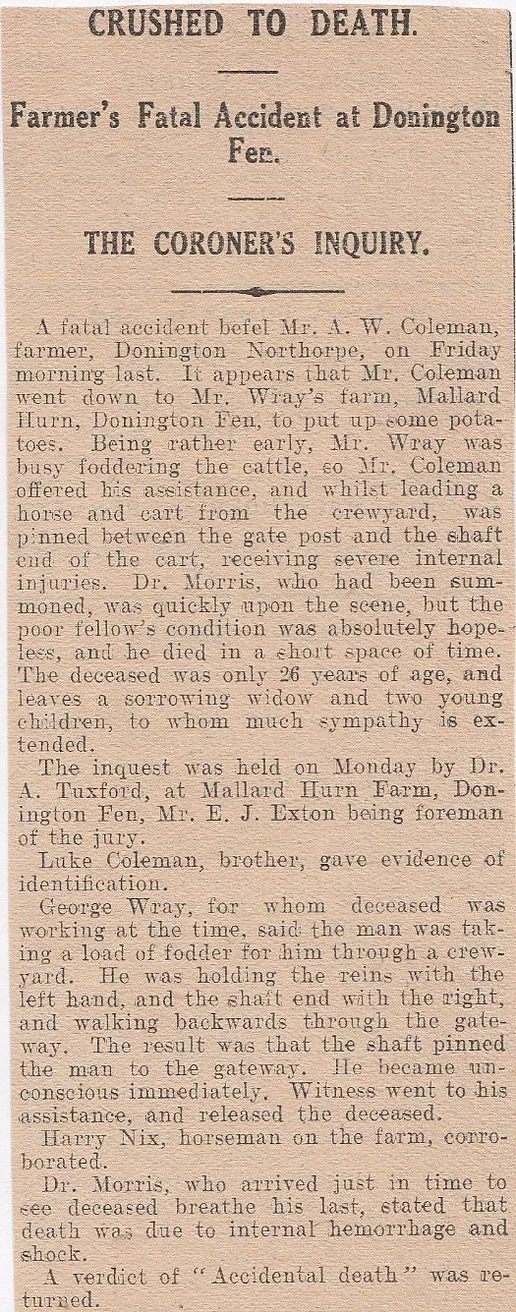
62/ Wigtoft, (Gored to Death by Bull) October 1889
A singular accident occurred at Wigtoft, that resulted in the death of a farmer. Thomas Richard Hides, a farmer in Swinehead and Wigtoft, was tying up a bull when the beast became irate and ran its horn into his head. The death of Mr Hides was instantaneous and this was not the first instance of the animal suddenly going bonkers, as it had been doing it for the last few weeks, with its behaviour becoming extremely volatile. The whole area around here is in a state of shock at the awful demise of this well-known agriculturist.
63/ Long Sutton Railway Station Death, September 1902
A housekeeper named Jessie Ann Cooper, aged twenty, was with her boyfriend named Bothamley, going on an outing to Manchester. They were just crossing the line at some hand-gates, when the express train from Yarmouth to Manchester hurtled through and sliced poor little Jessie in two. The boyfriend was holding her hand when she was struck by the train and he just missed the same fate, but he stepped back from the approaching engine just in time.
64/ Pinchbeck Divorce Suicide, (Spalding) July 1887
Fifty-seven-year-old shoemaker George Palmer killed himself by hanging from a beam in the wash-house, with a piece of clothes-line. Recently the Manchester stipendiary ordered him to pay ten shillings a week to his wife, with whom he had separated. An appeal was made but the decision went against him and he was unable to pay the costs of this appeal and consequently filed a petition for bankruptcy. All of these things upset him greatly, so he decided to end it all rather than pay her a penny.
65/ Victoria Court, Boston, (Child Drowns in Cistern) June 1888
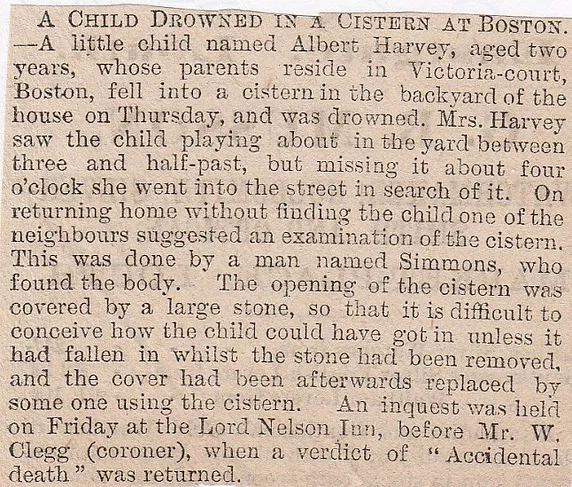
66/ Whaplode, August 1893 (Suicidal Family)
A farmer named Watson from Whaplode near Spalding was found hanged. This, it transpired, was the fourth case of self-destruction in his family. His nephew and an uncle had also hanged themselves, as well as Watson himself and a sister had slit her throat with a razor instead. The mother was suffering madness and a brother had recently been an inmate of an asylum.
67/ Long Sutton Suicide, May 1910
Alfred Brothwell killed himself by hanging himself from a beam in a shed at Long Sutton. He wrote his will in chalk nearby. It read:- “Give Alice £50, and Sally the other; don’t deceive me”. Apparently, he had been extremely distressed by the death of the King.
68/ Surfleet, (Child Fatality) October 1887
A little girl named Barron aged four years was playing on the road at Surfleet when she was knocked down by a passing trap. The wheel passed over her head and she also received a blow from the horse’s hoof. The child died within a few minutes of being picked up.
69/ Spalding Suicide, October 1887
John Lewis aged sixty-five, died at Spalding this Thursday. Nearly a month ago deceased cut his own throat with a razor while his wife was in the room, the latter supposing he was about to shave himself. A medical man was promptly in attendance, who stitched up the wound and it was hoped that Lewis would recover. He suffered a relapse on Thursday and died shortly after. Lack of employment and a fear of poverty drove him to commit the act.
70/ Church Street Suicide, Boston, May 1888
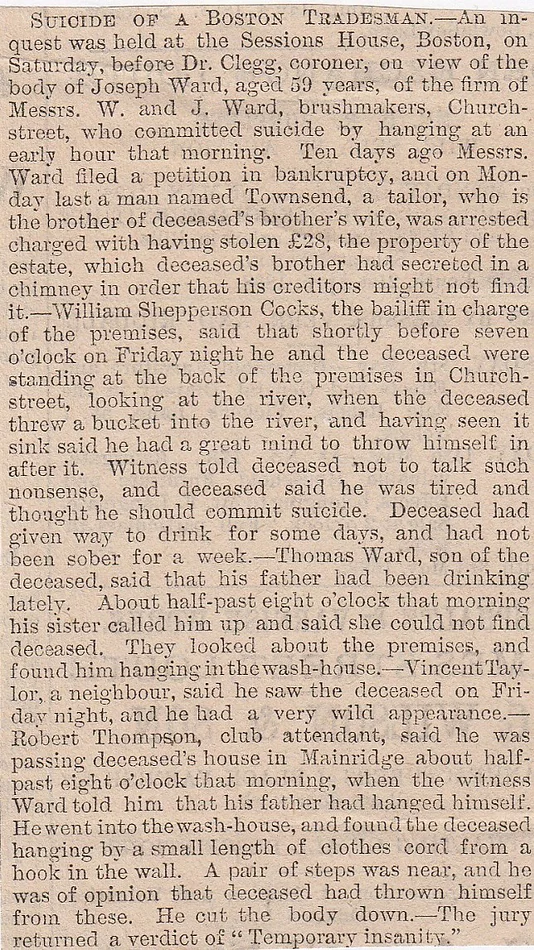
71/ Wyberton (Policeman Murder) November 1860
An officer of the Lincolnshire Constabulary, named Alexander McBrian, was shot in Boston and after lingering for a few days he expired from the wounds received. McBrian talked a little while he was in the hospital and he said that at one a.m., he was on his way from Frampton, towards Boston, when at Wyberton churchyard he came across a man who veered into a field with a gun in his hand, wanting to avoid him. Suspicious he went after him but the man turned around and fired. The officer identified a man named Thomas Richardson as his assailant and he was arrested soon after. (Was it Richardson?)
72/ Sutterton, January 1875 (Attempted Poisoning)
Harriet Thurlby, a domestic servant, was remanded on a charge of having given a quantity of arsenic with intent to poison her master and mistress, Mr and Mrs Pocklington at Sutterton. She was also charged with attempted poisoning of several other members of the family, by poisoning a pudding and giving them it to eat.
73/ Spalding Station-yard Fatality, November 1887
George Goodley aged twenty-two, from Uffington, was run over and killed in Spalding Station-yard by a passing train. There were two trains leaving Spalding Station at the same time-one to Holbeach, the other to Bourne. Goodley was walking home on the Bourne line and was spotted by the driver of the Holbeach train, who whistled to attract the attention of the other driver but he wasn’t seen in time and he was run over. He lingered for a while but eventually passed away. He died from consumption, accelerated by the effects of the accident.
74/ Horace Street, Boston, (Suicides) January 1916
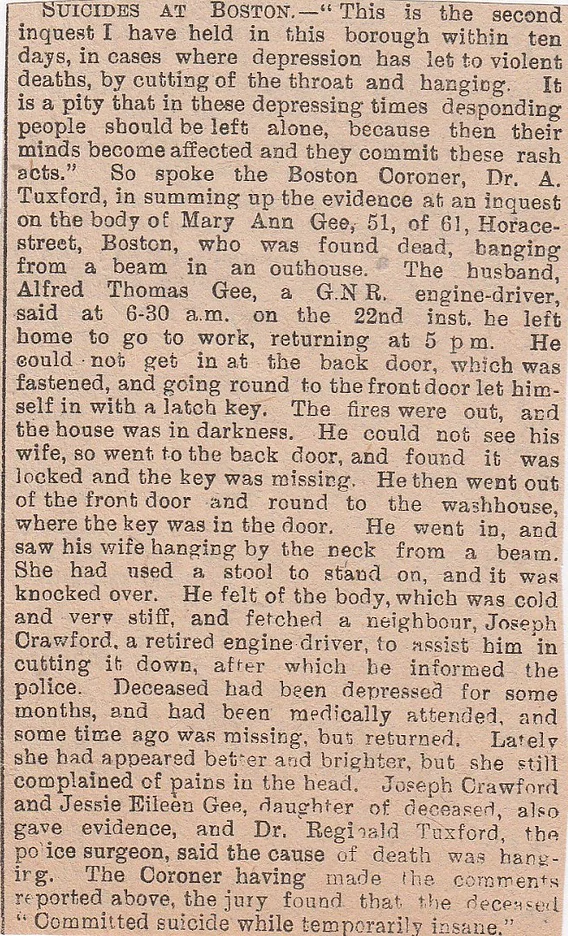
75/ Pinchbeck, (Girl Dies After Assault) October 1880
At Pinchbeck, as a girl was leaving the church and proceeding home, she was accosted by a man who assaulted her. As soon as she escaped she hastened home and called up her mother, who, being unwell, had retired to bed. As soon as the mother opened the door, the girl fell down dead. The man, who is a farm labourer named Kiddall, was apprehended.
76/ Wyberton West Suicide, August 1905
Charles Smith found a dead body in a shed at the back of his premises, hanging lifeless from a beam by a thin cord. The victim was Robert Warner aged seventy. Deceased had lodged with a family named Pogson near the “Hammer and Pincers” public-house at Wyberton. He worked as a roadman under the Rural District Council. A fortnight ago he was discharged due to his age and infirmity. This preyed on his mind and he was heard to say that he preferred death to the Workhouse.
77/ Bourne Fen near Spalding, June 1895 (Woman’s Body Found in Dyke)
On Monday, an inquest was held at Bourne Fen, on the body of an unknown woman who had been found drowned in a dyke in that locality on Saturday. It was evident that the body had been in the water for some considerable time, as the weeds and nettles around the spot had grown to a considerable height. A verdict of “Found Drowned” was returned.
78/ Caroline Street, Boston, June 1866 (Human Skeleton)

79/ Holbeach, (Man Roasted to Death) April 1882
A young man named Thomas William Bingham was put in a disinfecting apparatus to help cure his skin disease, with sulphur being burned underneath the box. He said it was getting hot but was told that it was OK and it was meant to be that hot, then they walked out of the room. When they came back he was unconscious and nearly dead. He lingered a while but finally expired not long after the incident. Apparently, there was too much sulphur in the box and the heated irons were way too big, which caused a build-up of heat and for the poor man to be literally roasted alive. The verdict was one of “manslaughter”, brought against the boss of Fleet Workhouse, Walter Brydges Waterer, but he was found not guilty and was discharged.
80/ Crowland, May 1908 (Forbidden Marriage Suicide)
Nineteen-year-old Herbert Copeman was discovered in some gravel pits at Crowland, quite lifeless. He was supposed to be married to a young lass from Crowland and the banns had been published, but his father had refused his consent which was legally necessary, with Herbert being underage. He bid his girlfriend goodbye on Sunday night, then cycled down to the pits and plunged in. The jury said he “committed suicide whilst temporarily insane” and added the father had every right to do what he did, not attaching any to him whatsoever.
81/ Long Sutton Child Killed, (Spalding) June 1888
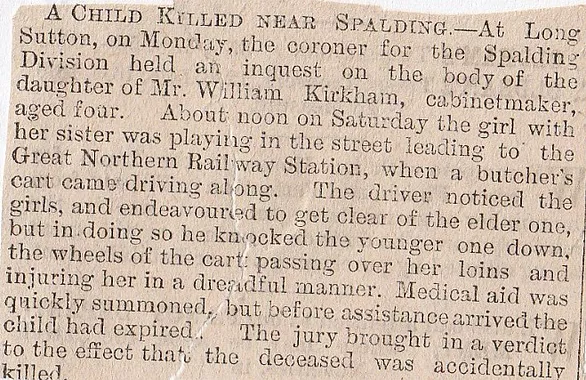
82/ Kirton Sheldyke, August 1902 (Four Drowned)
A sad tragedy took place at Kirton Sheldyke, approximately seven miles from Boston, when four people went to spend a day at the seaside, so decided to go to Kirton Sheldyke. Arthur Strange and Ida Mumford both from London, along with Ida Clayton and Mark Tomlinson, were all paddling at the mouth of the River Welland. The two women slipped into a deep pool and they shouted the men for help. They dived in to save them, but ultimately they all got stuck in the water and drowned. Tomlinson’s body was recovered soon after and one of the two women was washed up near Fosdyke.
83/ Donington Wife Murder, June 1897
A farmer from Donington by the name of Joseph Bowser was charged with the murder of his missus on the 25th of May. He liked a tipple and was an extremely violent man, with a short temper. Elizabeth Burridge, a servant in the household, was near her mistress at the time of the tragedy. She stated that Bowser shot her twice in the head while she was working in a field, then attempted to turn the gun on himself, but failed. When asked why he did it, he replied the whisky and his wife’s constant flirting was what caused his overzealous act. Bowser was sentenced to death after being found guilty of murder.
84/ Anton’s Gowt, July 1864 (Two Lads Drowned)
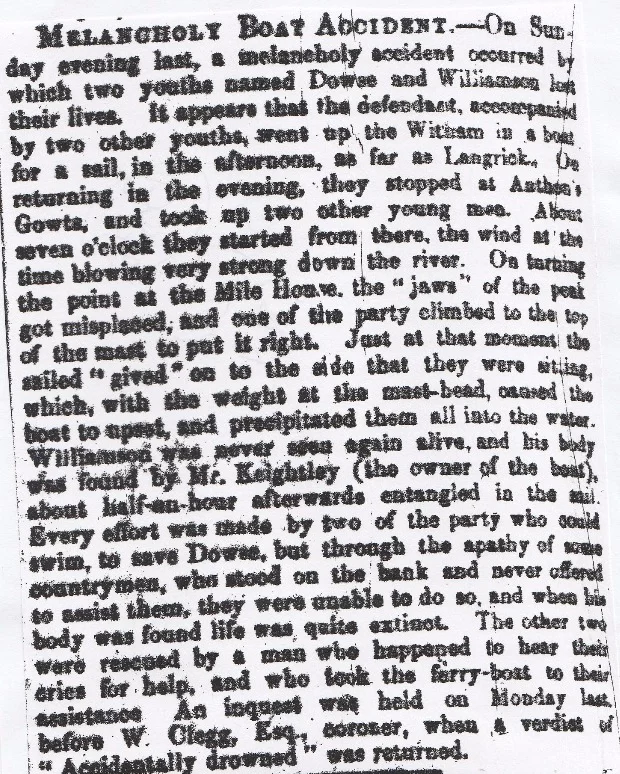
85/ Sutterton Dowdyke, July 1887 (Mary Ann Wharrie)
Mary Ann Wharrie was accused of the wilful murder of her illegitimate child. The boy, George Harold Wharrie, was born at Spilsby Workhouse which she left and headed to Sutterton. There, the child seems to have vanished but was later found in a hole in Mr Allen’s garden by some dogs. She claimed that she unintentionally gave the little mite a larger dose of laudanum than what was good for it, hence causing his death. She said she panicked and buried the child there. Wharrie was sentenced to death at the Nottingham Assizes but was recommended for penal servitude for life instead. (Still hung her though, didn’t they?)
January 1902
Mary Ann Wharrie died at Boston Hospital after falling and breaking a leg. Her sentence was commuted for the murder of her child and after serving seven years was liberated on ticket-of-leave, with her age then being forty-one. Nobody appears to have known about her dark past and the bloke she worked for gave her glowing references. Her funeral was stopped due to her death by misadventure going unreported. An inquiry will now be set a date.
86/ Boston Murder, 14th September 1886 (Charlotte Pacey)
Nineteen-year-old Charlotte Pacey, who worked for Mrs Newcomb of Queen’s Terrace in Boston, went missing one evening after putting down some purchases she had made and saying that she was off to meet her boyfriend and if he didn’t come then she was off to see some friends in Caroline Street. Police questioned the boyfriend, Charles Fovington, but he said she never saw him that night but he spotted her while on his way to Shodfriar’s Hall. her body was found floating in the North Forty Foot Drain in Boston West. Then at the end of October 1886, a labourer named George Smith confessed to murdering the girl.he accosted a policeman in Angel’s Lane, Stratford in East London and said that he killed Pacey by striking with his fist, then rifled her pockets but found nothing, so shoved her into the ditch nearby. He saw the headline in the papers a few days later about how the poor lass had been murdered and he fled to London. A couple of weeks after his confession, they came to the conclusion that although he was in that part of the country, he didn’t kill Pacey and he had done it to be imprisoned and to have food and a roof over his head. (Was murderer ever found?)
87/ North Street, Boston, October 1886 (Susan Pocklington aged 40- charged with manslaughter)
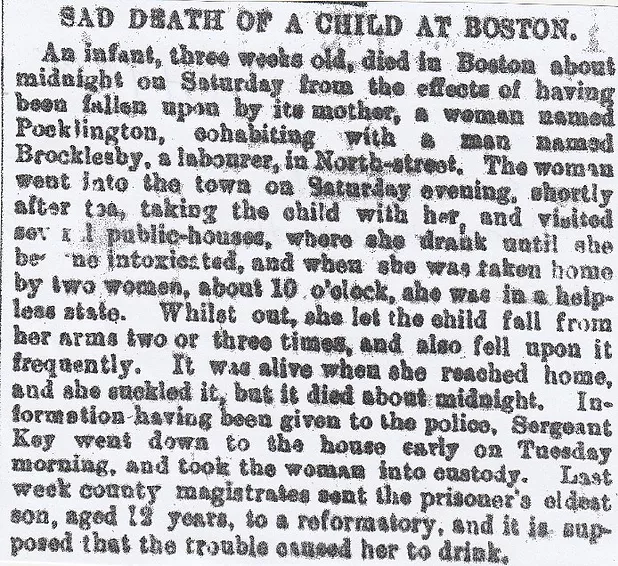
88/ Spalding Murder, November 1879
George Rolt, a rag and bone man, was found dead on the Pinchbeck Road, evidently a case of murder. He seems to have been bludgeoned to death by a blow on the back of his head, as he was walking across some fields on his way home, then he strangled to make sure. He was found by a shepherd within 300-400 yards of the market-place when it was packed with people the night before. Footprint casts were taken and a man’s cap was found near the body. A woman who cohabited with Rolt has been arrested. Rolt used to carry a large amount of gold upon him and this was known by several people. Henry Howitt was arrested at Sibsey and his house-keeper, 23-year-old Elizabeth Ireland and John Brewster Vessey were also apprehended for Rolt’s murder. Howitt confessed to police that they killed him and on February 7th, 1880, they were all sentenced to death.
In mid-March of 1880, this was in the papers:-
“The Spalding Murder- the three persons sentenced to death for the murder of George Rolt at Spalding and who were respited a few weeks since, have been sentenced to penal servitude for life. They passed through Spalding on Thursday morning, the woman wearing a hood which she wore the night of the murder. She appeared very unconcerned. The destination of the prisoners was probably Millbank.”
89/ Boston Public Park Suicide, September 1883
An inquest was held on the body of John Nicholls aged forty-eight, a labourer living in St John’s Road, and who was found hanging by the neck about midnight on Friday on the Public Park railings. Evidence showed that he had been a great drinker. About eleven p.m. Friday night, he went home drunk as a skunk and then soon afterwards went out again. On not returning a search was made in the neighbourhood and there he was found hanging on the railings of the Public Park.
90/ Skirbeck, (Pit Suicide) July 1883
The suicide of a farmers wife, Mrs Lanes, wife of Richard Lanes of Skirbeck, has caused quite a buzz in the neighbourhood. Her body was found in a pit on the farm and evidence revealed that she had been of unsound mind for a long time and had to be watched. Between two and three in the morning, she crept out of the house and killed herself. Her lifeless corpse was found in the pit, which was close to the house.
91/ River Welland Drowning, Spalding, August 1889
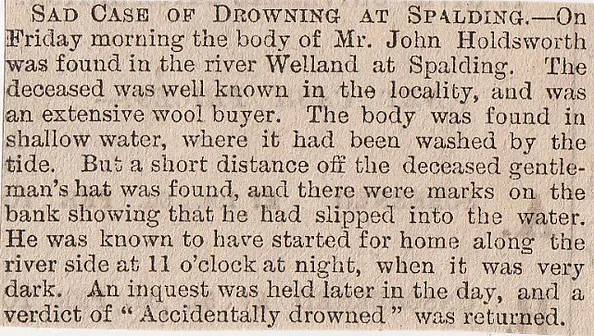
92/ Little Postland Suicide, near Spalding, May 1905
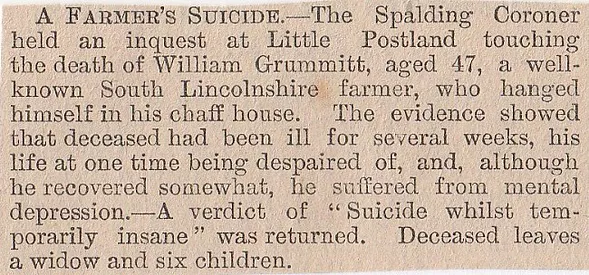
93/ Tower Street, Boston, September 1883 (Suicide of a Boy)
About 10-30 Monday morning, fourteen-year-old Barnet Jones, who is just finishing school, was left at home to look after some members of the family whilst his Mum went into town. On the mother’s return, she found her son had hanged himself with a piece of clothes-line under the staircase. An alarm was raised and the boy was cut down, but life was extinct. The Welsh father of the lad, Evans Williams Jones, has been the timekeeper at the Great Northern Railway Locomotive Works at Boston, had tried to get the boy a position at the Works, on which he seemed keen. There is no discernible reason why he killed himself and it was recorded as “Suicide whilst temporarily insane”.
94/ Dogdyke Railway Fatality, August 1883
George Whitton aged seventy-three, a sheath-maker from Sheffield, received fatal injuries at the railway at Dogdyke last night. He was part of a group of excursionists who were visiting the area for angling on the River Witham and that when the match was over he was clipped by a passing engine and hurled a considerable distance. He was unconscious and whisked off to the Boston Cottage Hospital, where he died shortly after admission. “Accidental Death”.
95/ River Glen, Pinchbeck, April 1884 (Child Murder?)
The body of three-year-old Gilbert Holmes was found floating on the surface of the River Glen at Pinchbeck. The man who found him thought that he showed signs of life and tried mouth to mouth, but he was already dead. Gilbert is the son of a local cattle dealer, John Holmes. The mother was seen nearby going into a cottage with her clothes soaking wet and told the people who lived there that she and her son had been in the drain. Mrs Holmes had previously mentioned that it would be best for her and the child to be out of the way. Mr Holmes said she had talked about her and the boy being drowned by her hand but he talked her out of such things. The couple had six kids together and it was after the birth of the first, that she became deranged and for six months she was an inmate of a lunatic asylum. (Post-natal depression?). Mrs Holmes was taken into custody by police on suspicion of murdering young Gilbert and also of attempted suicide.
96/ The Wash Drowning, December 1872
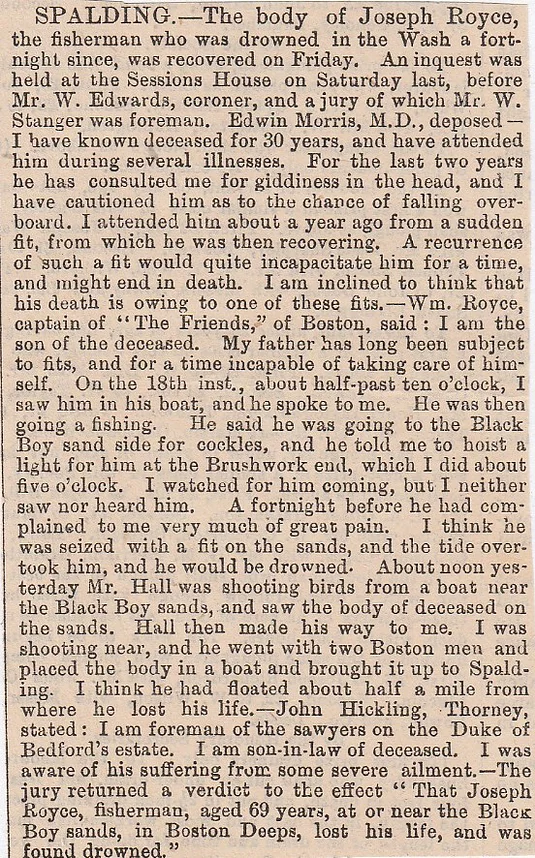
97/ Quadring, (Alcohol Poisoning) June 1900
Lucy Leverton aged twenty-one, from Quadring, swigged down a pint of neat whisky and lingered for a few days before expiring from the effects. Coroners jury gave the verdict of “Death from alcoholic poisoning”.
98/ River Witham, Boston, September 1887
An inquest at the Ram Hotel in Boston, on the body of Herbert Smith aged fifteen-years, who was drowned whilst attempting to swim across the Witham on Saturday afternoon. A verdict of “Accidentally Drowned” was returned.
99/ Tongue End (Spalding) (Two Men Burned to Death)August 1884
Two charred corpses were discovered in a stable that was used for storing oil cake, on Mr Shillaker’s farm at Tongue End. They were found by the foreman, and the were identified as father and son, named Canaan(?), the father being about fifty, with the son in his twenties and both being from Ireland. The two were allowed to sleep on the premises and as they had been out drinking that night, it is believed that a lighted candle fell into the straw in the stalls and set them alight. The son was found in a crawling position near the entrance and must have tried to get help, but only made it as far as the stable door. He was stark naked and suffered horrific burns all over his body.
100/ Sibsey, May 1878 (Gold in the Graveyard?)
More famous for being the birth-place of “Old Mother Riley” or Arthur Lucan as he was known to friends and family. This little tale is a story of buried treasure in the graveyard. Mary Ann Scott, who was a middle-aged lady, was given a medical examination and was held at Lincoln after her story that she had travelled from America to find gold and silver in her father’s grave at Sibsey. Scott left Liverpool and came to Lincoln, leaving a quantity of valuable luggage on the platform. When she was searched there was indeed a load of gold and lots of cash in U.S. Dollars, a pistol along with ammunition and gunpowder, plus a knife. (Was it true?)
101/ Tattershall Road Suicide, Boston, December 1915
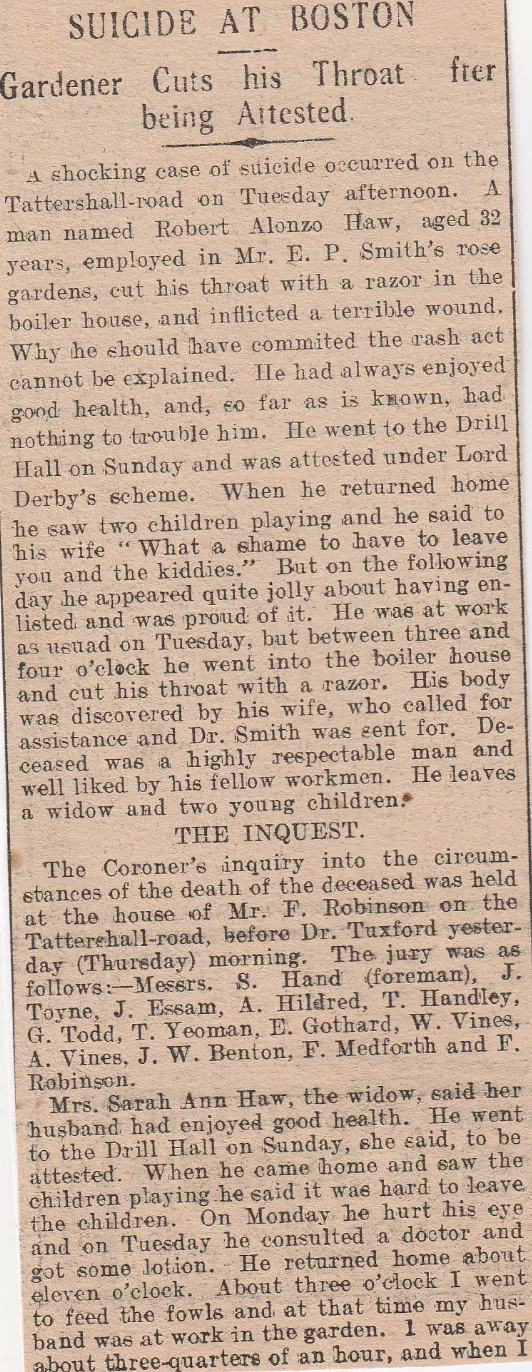
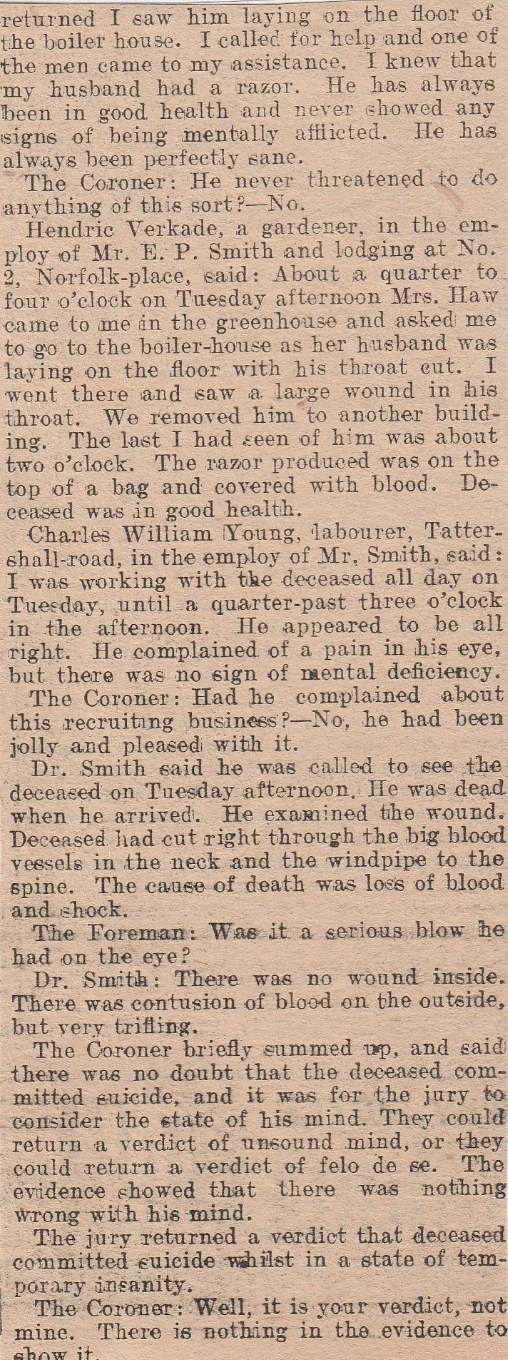
102/ Skirbeck Murder? January 1860
The body of a woman named Jane Jackson was exhumed at the cemetery. Deceased was the wife of David Jackson, millwright of Skirbeck, and died on December 8th, 1859 of an illness which she had for about ten days and was nursed by a woman named Catherine Taylor, who visited her. Medical men were baffled by her symptoms and the day after she died, Mrs Taylor fled to London. One of the surgeons was that suspicious so he requested permission from relatives to have her body dug up and for it to be tested for poisons. A large sum of money had also vanished and finding a forged note for £150 also got the tongues wagging in the neighbourhood. The corpse was exhumed and the husband was questioned. He stated that he’d been away from home when his wife died and said the forged note was not her hand-writing. Meanwhile, a portion of her intestines has been sent away for analysis and it could be weeks before any results come through. (Was she murdered?)
103/ Boston Dock, (8 Ton Weight Crushes Man) April 1884
Henry Neale was a beer-house keeper, who was sadly crushed to death on Boston Dock. He was the landlord of the “Hope and Anchor” and was working for Abbott and Son of Gateshead, helping to assist the erection of a large cylinder, part of the large coal-hoist, by means of a screw jack. The eight-ton weight fell on him, crushing him to death instantly. The jury recommended that better packing should have been used, but this was a bit too late for Henry.
104/ Sibsey Murder, July 1901
William Enoch Kirk, who was sentenced to death at the beginning of July for the murder of his wife at Sibsey near Boston, by slitting her throat, has been given a reprieve. At trial, he was pleading insanity and further investigation into his medical condition has resulted in the Home Secretary advising His Majesty to commute the sentence. (Diminished responsibility?)
105/ Spilsby Road, Boston, February 1887
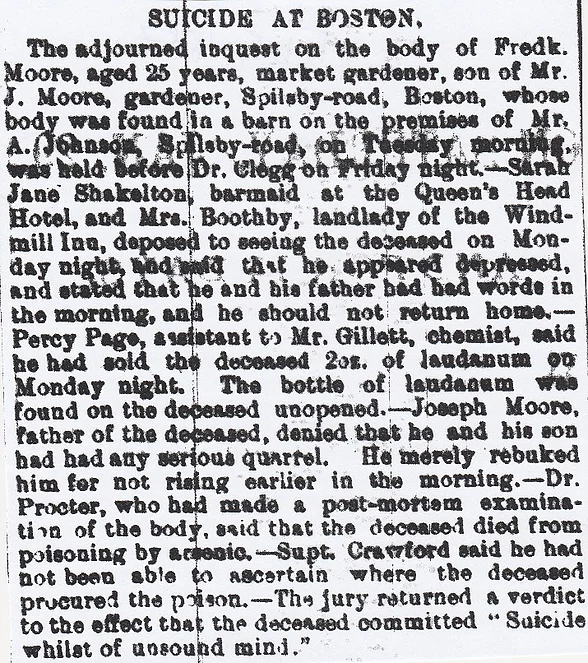
106/ Benington Double Child Murder, February 1844
Mary Johnson only twelve years old was charged with the wilful murder of her two brothers at Benington near Boston. Her story was, that she went to Mrs Overton’s shop to ask about a letter, it wasn’t there so she left. About ten minutes later, as in she strolls again, this time asks for a pennyworth of arsenic, which she was given! That night the two boys became violently ill and both died the next morning. The father had left the three children alone that night, while he went with the housekeeper to a chapel. When they got back the two lads were at a neighbour’s house in a dreadful state, vomiting and sweating. The father dragged the girl to the shop and asked if she had given her any arsenic, to which the shopkeeper replied “Yes”. The girl said it was for a woman she met on the roadside but that was all rubbish. Johnson was taken to Lincoln Castle and imprisoned there while awaiting trial, but she seemed fairly calm and if anything undisturbed by any of things were happening to her. The chaplain who she spoke to at the Castle, said that she had confessed to the crime to him. (What happened to her?)
107/ Whaplode, January 1860 (Suicide Day after Marriage)
William Sandworth aged forty, who, the day after his marriage, went down to a local pond and drowned himself. The deceased had married Mary Atkin and they had spent the night at her parent’s house at Whaplode. He woke up the next morning complaining of a terrible pain in his side, then he got dressed, walked out and went down to the pond and jumped in. The person he worked for said that he had seen the chap with fever-like symptoms and he was talking wildly and he thought that Sandworth was going mad or suffering from depression.
108/ Gosberton Suicide, September 1864
The wife of a local farmer at Gosberton, Mrs Mary Cooke, was discovered dead in a field. The chemist, William Peach, said she had been into his shop and purchased some mouse poison and an ounce of laudanum. The mouse poison contained strychnine. Her husband, William Cooke, told of how he left home at six a.m., leaving his wife in a fairly good mood. He did tell the jury that his wife was recently an inmate of a lunatic asylum and had been released in late June of this year, with a couple of attempted suicides in that time. On returning at eight o’clock, he found Mary had gone walkabout and feared the worse. The verdict was one of “Suicide by poison whilst of unsound mind”.
109/ Peacock Hotel Fatality, Boston, June 1861 (Was in Market Place, now demolished)

110/ Wyberton, June 1862 (Mysterious Drowning)
On the 12th June, as a youth was fishing in the Forty Foot Drain near Mr Taylors the brickmakers, adjoining Wyberton Chain Bridge, he noticed the dead corpse of a man floating in the water. He called Mr Taylor who managed to fish the body out of the water and found the man to be already beyond help, as clearly he had been in the water for a number of days. They found a silver watch with a gold chain, along with £5 in cash, a railway pass and a pocket-book, but no identifying paperwork of any sort. The pass was taken to the Railway Station by a policeman and found it that it was George Baxter’s, who was paymaster at the G.N.R at Doncaster. His father was Mr Baxter of Skirbeck Quarter and was due to get married very soon. He said he was going away for a couple of days and reached Boston at 9-15 one evening. He gave his bag to a porter and said he’d be back later to collect it. He must have then made his way through West Street along Sleaford Road, to the Forty Foot Drain and there he killed himself.
111/ Boston Triple Child Murder, July 1844
Eliza Joyce aged thirty-one, was charged with the wilful murder of her two children. The first victim was eighteen-month-old step-daughter, Emma, whom she poisoned with laudanum in October of 1841. By the exact same method, she then killed the six-week-old daughter, Ann Joyce, in January of 1842. The evil cow also killed her step-son, Edward William Joyce. She confessed to all three murders while she was in the workhouse after she and her husband had split up.
16th August 1844
At the gallows at Lincoln Castle, Eliza Joyce was hanged for her cruel murders of three innocent children. A crowd of approximately 5000 spectators were there to watch her fate at the hands of William Calcraft.
112/ West Street Suicide, Boston, May 1880

113/ Wrangle May 1884 (Mary Lefley)
This case was probably one of the best-known murders committed in Victorian times in the Boston district, along with Priscilla Biggadyke. Mary Lefley aged forty-nine was hanged at Lincoln Prison for the crime of wilfully murdering her husband, with a poisoned rice pudding in February of that year. What is strange about the case, is that the amount of arsenic in the pudding wasn’t noticed by her husband. It states that two grains of arsenic can kill a grown man and she put 135 grains of arsenic in her fifty-nine-year-old hubby’s pudding and he still lapped it up!
May 1892
An old man had died in the village of Wrangle in 1892, and he claims, on his death bed, to have procured the arsenic with which Mary Lefley poisoned her husband. He also claimed that the two of them were on intimate terms and ever since she was hanged at Lincoln Prison in 1884, it has preyed on his mind. He, therefore, was an accessory to murder, but nobody could say or figure out how she got hold of that amount of arsenic. Lefley protested her innocence right up to the moment the trap-door opened.
114/ Cowbit Drownings, near Spalding, December 1883
An inquest at Cowbit touching on the death of two young men named Batterham, who were drowned the previous afternoon. The deceased were rowing on Cowbit Wash when they overbalanced and the boat capsized throwing the two cousins into the water. Neither were good swimmers and they both drowned very quickly. A woman saw one of the lads rise to the surface and went to raise the alarm but neither of the bodies was recovered till nearly an hour after the accident.
115/ Sibsey Murder, March 1859
William Stevenson aged sixty-four, lived at Sibsey with his son. He went to Boston Market one day with a few quid about him when on his journey home he stopped off for a pint at the Ship Inn. Three men Edward Sands, William Pickett and Henry Carey entered the place when an argument broke out between Sands and Stevenson. To calm the situation down he took out some cash and got them all a drink. They must have seen his wad of cash because the next time Stevenson was seen he was face down in a ditch, dead as a dodo. All three were apprehended for the crime and only Carey and Pickett hung for it. A crowd of around 25,000 turned up to watch them squirm on the gallows. Pickett struggled for a couple of minutes, writhing about, whereas Carey’s neck snapped instantly.
116/ Deeping St Nicholas, (Shocking Death) October 1887
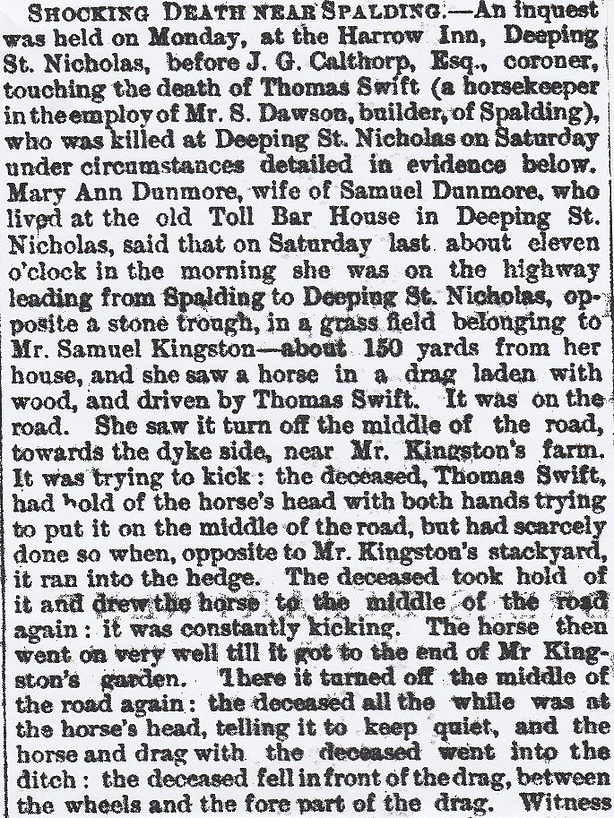
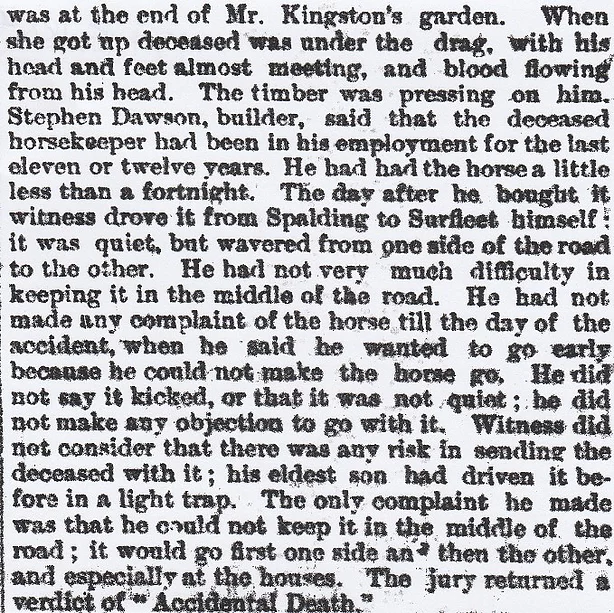
117/ Sibsey Wife Murder/Suicide, December 1902
A man named Root aged sixty, who was a plate-layer and resided at the Gate House at Sibsey High Ferry, had an argument with his 62-year-old missus and he threw her out of the house. She fled to Frithville and stayed with their daughter. After giving it the weekend for everyone to calm down, he headed for Frithville, but this wasn’t to kiss and make up. He took his axe with him! He lunged at her, splitting her head open with just one blow, then he legged it and committed suicide by putting his head on the railway line and letting a train run over him.
118/ Hammond Beck Drain (Boston) (Body in Drain) October 1880
Albert Morton, a farmer residing at Frampton Fen, was found drowned in Hammond Beck Drain, which runs past his farm. Morton left Boston with a neighbour called Pridgeon and before they got very far the two parted company, as Pridgeon had to call at a grocer’s shop. Pridgeon tried to overtake Morton, but failed to do so and went home. On Sunday morning, Morton hadn’t returned and his wife grew uneasy and told Pridgeon that he wasn’t back yet. Pridgeon organised a search, went to Boston and asked around, but nobody had seen him. A search was made of the drain and that’s when his corpse was found, about a mile from his house. Morton leaves a widow and six children and is believed to be a tragic accident.
119/ Quadring Murder, September 1842
Mary Spencer was left a cottage by her father, which she adapted into a day school. It only had a couple of rooms, so she lived in one, with the school in the other. Three kids opened the door at nine a.m. on Friday morning and found poor Mary drenched in blood and wearing only her night-clothes. They ran away screaming and banged on the neighbour’s door and he, in turn, called for a surgeon from Gosberton, who discovered a nine-inch long wound from her neck to her chest. On checking the building they discovered that the murderer had got in through a back window. They arrested a bloke named William Howett, albeit in an amazing coincidence. Mr Loughland was measuring some land when he started a conversation about the killing of Miss Spencer and whose father would be sat down taking a tea-break; yes you’ve got it, Howett’s father, who exclaimed:
“I wonder what Bill’s been up to this time, he was out all night and came back covered in blood”. Howett was apprehended and is definitely the killer of poor Mary Spencer.
120/ Weston Wife Murder, near Spalding, May 1899
Edward Bell aged twenty-six was charged with poisoning his wife, Mary Elizabeth Bell, with a cocktail of strychnine and mercury. The mother said her daughter got worse as he gave her a powder, supposedly given to him by a doctor. A week later she received a letter from Bell stating that the doctor hadn’t given him the powder and that he was miserable and was going to leave the area. Here’s the juicy part of the story….Bell was seeing another woman behind his wife’s back, Mary Sheila Hodson of Ramsey in Huntingdonshire. They met at Gedney and were writing love letters to each other and they got engaged on May 1st, a couple of days after his wife’s funeral!
June 1899 (Bell’s Sweetheart Mobbed)
Edward Bell was taken back to Lincoln Prison after being in Spalding courts, with his departure postponed until the evening, when two police officers took him to Surfleet in a cab to avoid a demonstration at the Railway Station. Miss Hodson left Spalding and headed for Peterborough and she too met hostility from the crowds, so it was decided that she would be held back for a few hours until things calmed down. A crowd had gathered at the Station with dozens of adults clambering to get a glance of her, swearing and making rude gestures. For nearly half an hour the police kept her in the waiting room, away from the mob. As she finally got on board the train, there was hissing and booing from all persons present.
121/ Boston Haven Drowning, October 1863

122/ Boston, (Suicide in Chemist’s) February 1863
Eighteen-year-old John Maltby Dawson was an apprentice to a chemist, Mr E.Lewis of Market Place in Boston, and the lad killed himself by taking some prussic acid. Lewis described a boy that was hard-working and had been with him for three years. Another young lad was doing an apprenticeship and there was animosity on Dawson’s part. Dawson went down to the cellar and was gone a few minutes, when Lewis found him, he was sat upright on a hamper with the bottle of prussic acid in his hand. It was deemed to be a “suicide under temporary insanity” and the lad was buried at Keddington Church near Louth.
123/ Boston Haven, (Body in Haven) April 1864
The body of Ann Lunn was found floating on the surface of Boston Haven near to the packet-yard. Her pockets had four shillings in them and a small hymn book. The appearance of the body would suggest that she had been in the water for some days, being slightly decomposed. The body also had several large bruises on it, but these could have been made by a foreign body after her death. The verdict was one of “Found Drowned” as they weren’t aware if was accidental or a deliberate suicide.
124/ Boston Haven Mystery, April 1864
125/ Fishtoft, (Double Child Murderer) March 1876
William Gilbert Harrod was indicted for the wilful murder of William Henry Hebblewhite on 19th February 1876. Nothing unusual in that you may say, but this murderer was only twelve, with his victim being a ten-year-old boy. Even stranger still, is that he is a rare breed of child double murderers, with his other victim being Albert Hockley aged five, on October the 2nd 1875. Harrod had been accused of bullying poor Hebblewhite and when the two had a chance meeting on the roadside, Harrod took the opportunity for revenge. The two started scrapping and Harrod got a wooden stake and bashed his head in with it, then lobbed him in a pond.
Harrod was found guilty of manslaughter, with the charge of Hockley’s murder not being prosecuted.
126/ Boston, September 1901 (Attempted Murder/Suicide)
Thomas Wakefield attacked his missus with a knife, slashing her face, throat and head, then tried to kill himself by slitting his throat. They were both found and rushed off to the hospital, with neither of them expected to pull through. The children witnessed the whole thing and describe a frantic struggle between the two, with Mrs Wakefield escaping, then hurdling a six-foot fence in the backyard and was helped by the neighbours. A butcher’s knife was discovered at the scene. Relatives and friends tell of an unhappy relationship between the two, always at each other’s throats. A letter was also found at the premises signed by Wakefield, clearly stating that he was going to kill his wife and then himself. (Did either survive?).
127/ Cowbridge Crossing Suicide, Boston, September 1887
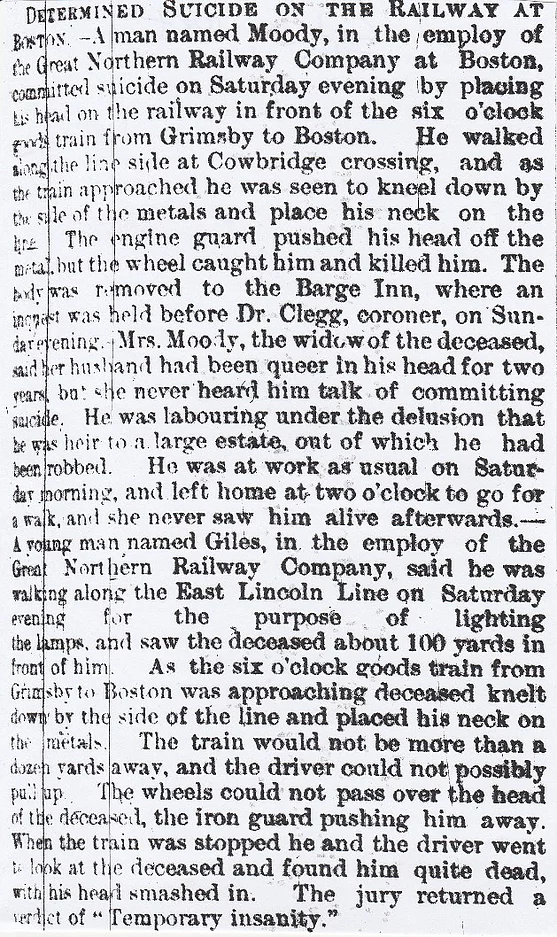
128/ Moulton Innkeeper Drowned, near Spalding, June 1888
An inquest was held at Moulton touching the death of William Osbourne, an innkeeper of Moulton. He had left home to go to Spalding Market on Friday morning but he did not return home that night and nothing was seen or heard of him again until his body was found in a pit by the roadside along from Moulton to Spalding, about fifty yards from the deceased’s home. It was ascertained that the deceased, on his way back home called at a public-house against Moulton Railway Station and left there on Friday evening, about 10 o’clock, in a perfectly sober condition. The body was found by a boy who was in an adjoining field. The verdict “Found Drowned”.
129/ Maud Foster Drain, Drowning, near Boston, November 1862
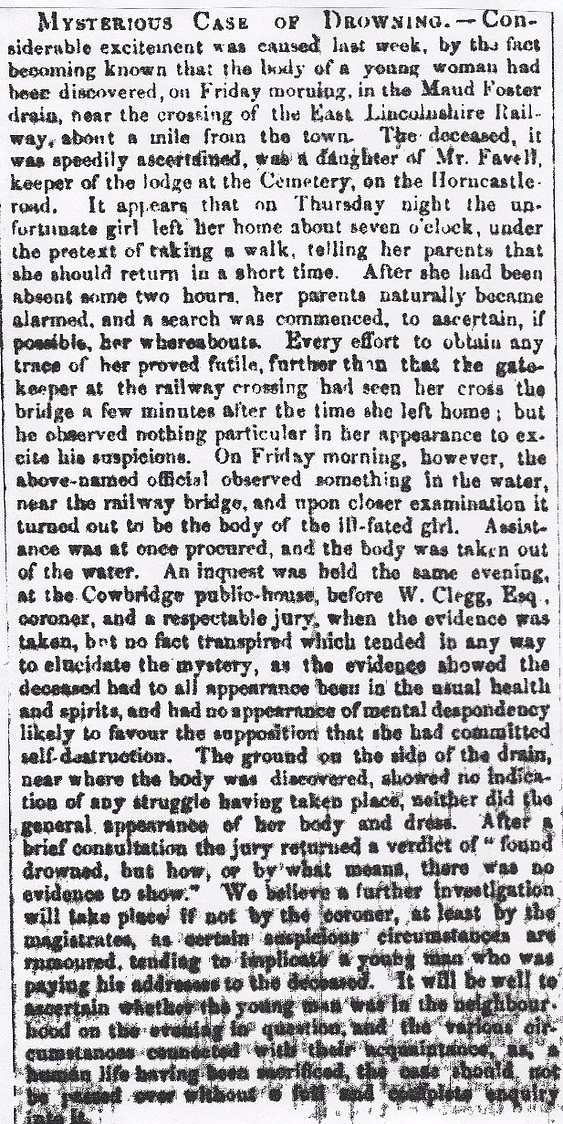
130/ Archer Lane Suicide, Boston, November 1887
42-year-old John Brocklesby took an overdose of opium and killed himself. His mother said he visited her in Archer Lane and he had clearly been out drinking. He said he’d had a quarrel with his wife and that he wouldn’t speak to her ever again, that then he’d bought some opium which he was going to take. He went out that night and was brought back by three men, who dropped him off at her house and he lay asleep on the sofa. The mother woke at three a.m. and remembered what her son had said about the opium and she went down to check if he’d not done anything stupid. She sent for the police, and they, in turn, sent for a doctor, but he was dead by 10-00 a.m. the next morning. He had tried to kill himself before, in 1868 in fact, by taking some laudanum, so he was prone to suicidal tendencies.
131/ Spalding Police Station Fatality, January 1862
Sarah Goode, or Gooch aged twenty-two who was a domestic servant of William Ward of Spalding, died in a police lock-up. Mr Ward said that she was a good servant, but after only a month there she handed her notice in saying that she didn’t want to be treated so unkindly. Ward replied that she hadn’t bee ill-treated in any way and asked her to stay. However, she ignored his pleas and packed her boxes and left a couple of days later, but left the boxes at his house. A couple of days after that she turned up on the doorstep asking if she could get a dress out of the box, with her request allowed. A rumour reached Mrs Ward that some stolen collars were in her possession and Mrs Ward asked if she could look in them, but she objected. Goode was apprehended and placed in the cell on the charge of having stolen property in her possession. The fact was, she was an orphan and had nowhere to go, no money and a little sister in the Swaffham Union House. All of these things preyed on her mind. The policeman on night duty heard a groan, then he entered and she was there with her arms extended, knees were drawn up and one eye was set and she was insensible. A doctor was sent for and he found no pulse and she was pronounced dead at three a.m. The Coroner said she had died from “Natural Causes”, in a way she had worked herself into a frenzy and the nervous system could not cope. (Medically what does it sound as though she died from?)
132/ Little London, Spalding, (Wheelchair into the Welland) December 1915
